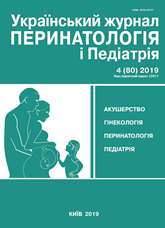Leopard syndrome: multiple lentiginosis and hypertrophic cardiomyopathy. clinical case
DOI:
https://doi.org/10.15574/PP.2019.80.93Keywords:
Leopard syndrome, lentigo, ocular hyperthellorysm, hypertrophic cardiomyopathy, lentigines, PTPN11 geneAbstract
Leopard syndrome (LS) is an autosomal dominant disease characterized by multiple lentigo and café-au-lait spots, ECG disorders, ocular hypertellorism, obstructive cardiomyopathy, pulmonary artery stenosis, male and female genital pathology. The frequency of this syndrome is unknown, nearly 200 clinical cases have been described in the literature so far.The clinical case. The article presents the clinical case of a girl with Leopard syndrome who was admitted to the pediatric department of Lviv Regional Hospital OHMATDYT with the complaints of learning difficulties compared to her peers, fatigue, frequent headaches, shortness of breath, and exacerbations during exercise. On examination: general state of moderate severity. Skin and mucous membranes pale — pink, hypertellorism of the eyes was determined, multiple pigmented lentigenes spread throughout the body and hyperhidrosis of the palms. Physical development — below average. Peripheral lymph nodes not enlarged. On ausculation: vesicular breath sounds, muffled heart tones, heart rate 90 beats/min, intense (4/6) systolic murmur in 2–4 intercostal space to the left and at the apex. Arterial blood pressure — 110/60 mmHg. Signs of systolic overload and left ventricular hypertrophy and of the left ventricular posterior and lateral ischemia on ECG. Hypertrophic cardiomyopathy, an asymmetric, obstructive form, was diagnosed during the echo-cardiographic examination. With intracardiac gradient — 66–106 mmHg. ENT doctor consultation revealed bilateral sensoneural hearing loss of II degree, more pronounced on the left. Ophthalmologist consultation — Vis OD:OS=0.4:0.4. The fundus — pathological changes were not detected. Vision correction — (-3). The diagnosis is mixed astigmatism, amblyopia. Pathology of genitalia was not found on examination by a pediatric gynecologist. After the paraclinical examinations, the child was referred for consultation by a geneticist and a clinical diagnosis was established «Leopard syndrome, multiple lentigo syndrome».
Conclusions. The phenotype of LS is extremely heterogeneous with clinical manifestations ranging from minor facial dysmorphia and multiple lentigo to patients with severe hypertrophic cardiomyopathy, mental retardation and deafness. The presence of multiple lentigenes makes it possible to suspect the syndrome and to conduct a thorough clinical and genetic examination in a timely manner. The absence of lentigo in early childhood and the similarity of the clinic to Noonan syndrome complicates early diagnosis of the syndrome. Most often children with LS are diagnosed with hypertrophic cardiomyopathy, which should be closely monitored by a cardiologist to prevent sudden cardiac death.
The research was carried out in accordance with the principles of the Helsinki Declaration. The study protocol was approved by the Local Ethics Committee of all participating institution. The informed consent of the patient was obtained for conducting the studies.
No conflict of interest were declared by the authors.
References
Gorlin RJ, Anderson RC, Moller JH. (1971). The Leopard (multiple lentigines) syndrome revisited. Birth Defects Orig Artic Ser. 7 (4): 110–115.
Sarkozy A, Digilio MC, Dallapiccola B. (2008). Leopard syndrome. Orphanet J Rare Dis. 3: 13. https://doi.org/10.1186/1750-1172-3-13; PMid:18505544 PMCid:PMC2467408
Morteza Moatamedi A, Mohammad Derakhshan. (2019). Leopard syndrome: a case report and literature review. Clinical Medicine. 19 (3): s23. https://doi.org/10.7861/clinmedicine.19-3-s23; PMid:31345866 PMCid:PMC6752376
Вentires-Alj M, Kontaridis MI, Neel BG (2006). Stops along the RAS pathway in human genetic disease. Nat Med. 12: 283–285. https://doi.org/10.1038/nm0306-283; PMid:16520774.
Limongelli G, Pacileo G, Marino B, Digilio MC, Sarkozy A, Elliott P, Versacci P, Calabro P, De Zorzi A, Di Salvo G, Syrris P, Patton M, McKenna WJ, Dallapiccola B, Calabro R. (2007). Prevalence and clinical significance of cardiovascular abnormalities in patients with the LEOPARD syndrome. Am J Cardiol. 100: 736-741. https://doi.org/10.1016/j.amjcard.2007.03.093; PMid:17697839.
Sarkozy A, Conti E, Digilio MC, Marino B, Morini E, Pacileo G, Wilson M, Calabro R, Pizzuti A, Dallapiccola B (2004). Clinical and molecular analysis of 30 patients with multiple lentigines LEOPARD syndrome. J Med Genet. 41: e68. https://doi.org/10.1136/jmg.2003.013466; PMid:15121796 PMCid:PMC1735759.
Limongelli G, Sarkozy A, Pacileo G, Calabro P, Digilio MC, Maddaloni V, Gagliardi G, Di Salvo G, Iacomino M, Marino B, Dallapiccola B, Calabro R (2008). Genotype-phenotype analysis and natural history of left ventricular hypertrophy in LEOPARD syndrome. Am J Med Genet A. 46: 620–628. https://doi.org/10.1002/ajmg.a.32206; PMid:18241070
Gorlin JR, Cohen MM, Levn LS: Leopard syndrome. Syndromes of the head and neck. Edited by: Gorlin JR, Cohen MM, Levn LS. (1990). New York: Oxford University Press: 461-464.
Ucar C, Calyskan U, Martini S, Heinritz W (2007). Acute myelomonocytic leukemia in a boy with LEOPARD syndrome (PTPN11 gene mutation positive. J Pediatr Hematol Oncol. 28: 123–125. https://doi.org/10.1097/01.mph.0000199590.21797.0b; PMid:16679933
Yu Nakagama, Ryo Inuzuka, Kayoko Ichimura, Munetoshi Hinata, Hiroki Takehara, Norihiko Takedo. (2018). Accelarated Cardiomyocyte proliferation in the heart of a neonate with LEOPARD Syndrome-associated Fatal Cardiomyopathy. Circulation: Heart Failure. 11: 1–3. https://doi.org/10.1161/CIRCHEARTFAILURE.117.004660; PMid:29602897
Downloads
Issue
Section
License
The policy of the Journal “Ukrainian Journal of Perinatology and Pediatrics” is compatible with the vast majority of funders' of open access and self-archiving policies. The journal provides immediate open access route being convinced that everyone – not only scientists - can benefit from research results, and publishes articles exclusively under open access distribution, with a Creative Commons Attribution-Noncommercial 4.0 international license(СС BY-NC).
Authors transfer the copyright to the Journal “MODERN PEDIATRICS. UKRAINE” when the manuscript is accepted for publication. Authors declare that this manuscript has not been published nor is under simultaneous consideration for publication elsewhere. After publication, the articles become freely available on-line to the public.
Readers have the right to use, distribute, and reproduce articles in any medium, provided the articles and the journal are properly cited.
The use of published materials for commercial purposes is strongly prohibited.

